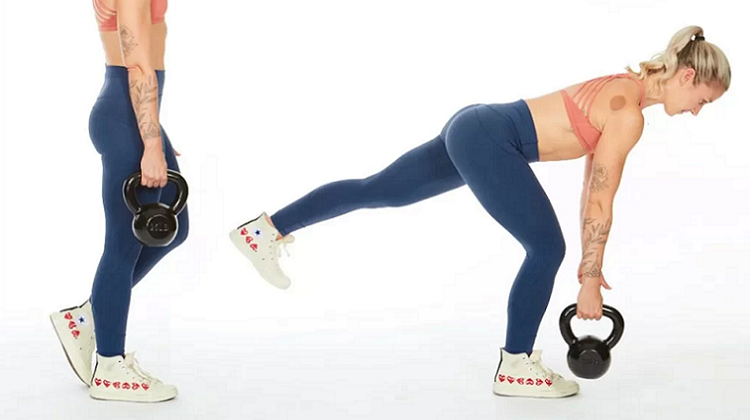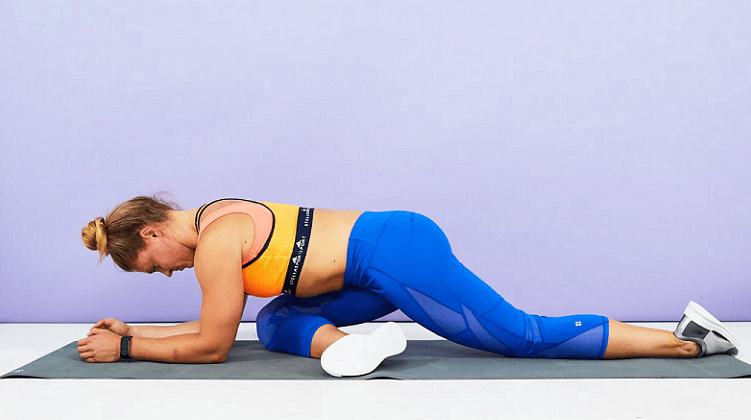With this 45 minute full bodyweight and kettlebell beginner workout routine, you will be able to shed excess body fat while also building your muscle, strength and endurance levels.
The beauty of this exercise regime is that you can perform it at home or at your local gym either after an intense strength training session or during an active rest day from your weekly workout routine.
In terms of equipment, all you require to get started with this 45 minute full bodyweight and kettlebell workout today is an open space at home or at a gym, an exercise mat, a stopwatch or clock to keep to time, a single light to medium size kettlebell and your undivided attention.
The reason why you need to make use of a light to medium size kettlebell is because the primary aim of this workout is not to build strength with a heavy kettlebell, but rather to encourage loads of high intensity repetitions (reps) for each kettlebell exercise to work your cardio and stimulate lipolysis and fat loss.
How to Perform a 45 Minute Bodyweight and Kettlebell Home Workout Session
You begin this 45 minutes bodyweight and kettlebell workout session with a warm-up routine to get your blood flowing and put you on track for a high intensity cardio workout.
After you have warmed up, you begin this 45 minute workout session made up of two circuits consisting of a combination of bodyweight and kettlebell exercises.
Each circuit should take about 13 minutes to complete with 2 minutes added-in for rest time at the end of the first circuit and before the start of the second circuit.
Note that you should aim to perform as many reps as you can for each bodyweight or kettlebell exercise routine in each circuit and the number of reps you are able to execute should be done within the one minute time frame allowed for each workout in the circuit.
Before you transition from one exercise to another, you get to rest for a brief moment of at least 20 seconds and you then round-up this home workout session with emphasis on performing a series of cool-down body movements.
5 Kettlebell Exercises to Perform
Your circuit should consist of five kettlebell exercises, namely;
Kettlebell Halo
This kettlebell exercise is designed to train your upper back, delts, traps, rotator cuffs and arms. Maintain good form when executing this exercise by having a tight core all through the movement with your hips remaining stable as well.
Make sure that you move your shoulders even as you spread the weight of the kettlebell around the full circle of your movement around your head and not your head moving around the kettlebell.
Keep your chin up even as you avoid a scenario where the kettlebell is lifted at a distance that is just too far from your head.

Kettlebell Swing
To execute the kettle swing, you start by placing the light to medium size kettlebell between your lower thigh or knees. You maintain good form as you swing the kettlebell upwards by engaging your core and using your hips for leverage.
Use your arms only as straps or a form of lever for the kettlebell as you swing up. Be careful to control the kettlebell swing, especially once it attains the peak of the swinging motion and when gravity brings it back down to the starting position.
Kettlebell Row
The kettlebell row exercise is similar to performing a single-arm dumbbell row workout routine with the exception that the weight is felt just below the handle.
If you want to perform a single-arm kettle row, you need to lean forward a bit with your inactive arm placed either on a stationary, stable object, such as a chair or on your knee.
You then pull the kettlebell as far up as you are able to while in the same motion contracting the muscles of your back.
As you reach the peak of the lift, gently lower the kettlebell to the starting position fully extending your arm in the process. Train one side for 30 seconds before switching to the other side and performing the same number of reps of the one-arm kettlebell row exercise for yet another 30 seconds.
Goblet Squat
In performing the goblet squat, you are allowed to hold onto the kettlebell wherever you feel the most comfortable, which may be at the bottom of the kettlebell or at the horns (or sides of the handle).
You have to lift the light or medium size kettlebell up your shoulder height for this exercise even as you squat in the process. Your squats should be slow and such that your thighs will be at a parallel angle to the ground before rapidly driving yourself back up while maintaining a comfortable hold and control of the kettlebell. Make sure you execute the goblet squat properly or you would fail to reap the gains that this exercise brings to the table.
Kettlebell Single Leg Deadlift
To perform the kettlebell single leg deadlift exercise, you need to hold the kettlebell in one hand. If for example, you hold the kettlebell in your right hand, you need to plant your right leg back while you train your left one.
Likewise, if you hold the kettlebell in your left hand, then your left leg should be planted to the back while you train your right one.
You start by gradually lowering the kettlebell down which results in your hamstring being stretched. If you use your left hand, your right hamstring will be stretched while if you use your right hand to lower the kettlebell, then your left hamstring will be stretched. Spend a total of 30 seconds for each hand working your left and right hamstrings in the process.
As you lower the kettlebell with either your left or right hand, attempt to touch the ground with the weight. If this is not possible, try to lower the kettlebell as low as you are able to while you feel your hamstring (left or right) stretching in the process.
In a situation where you find it easy to lower the kettlebell weight to the ground, you can increase your range of motion by standing on a step.

45 Minute Bodyweight and Kettlebell Home Workout for Beginners
The table below shows a total of ten exercises, five kettlebell workouts and five bodyweight routines. You will alternate between these exercises and rest for at least 20 seconds before the start of an exercise.
At the end of the day, this home workout routine will help to stimulate fat loss while at the same time promote both muscle mass and strength gains.
| WORKOUT | WORKOUT SUMMARY |
| Push Up | This bodyweight workout that trains core muscles, anterior deltoids, triceps, and pectoralis (minor and major) muscles. You should perform this exercise for 60 seconds. |
| Kettlebell Halo | The kettlebell halo exercise trains your core, erector spinae, upper back and shoulder muscles. Perform this exercise for 60 seconds with 30 seconds dedicated to each direction. |
| Lying Leg Raise | The lying leg raise exercise is effective in working your postural muscles which are those deep muscle groups located in your back, pelvis and abdomen. You should perform this bodyweight exercise for 60 seconds. |
| Kettlebell Swing | Kettlebell Swings will help to improve your grip strength while working the muscles along your posterior chain including your upper back, spinal erectors, glutes, and hamstrings. You should do as many reps as possible under 60 seconds. |
| Abdominal Crunch | Abdominal Crunch is a core exercise that trains your abdominal muscles as well as your obliques, hips, lower back and pelvis muscles. Spend 60 seconds performing this exercise. |
| Kettlebell Row | The kettlebell row exercise is great for training your biceps, back, rhomboids, abs, and traps. You should do as many reps as you can under 60 seconds with 30 seconds spent on each side. |
| Bodyweight Jump Squat | Train your calves, hamstrings, glutes, quads, core, arms, and upper body with 60 seconds of bodyweight squat jumps. |
| Kettlebell Goblet Squat | Goblet squats train your quads, glutes, calves, core, and arms while also improving your grip strength. You should perform as many reps as you can in 60 seconds. |
| Alternating Bodyweight Lunge | This exercise will strengthen your lower body muscles while also stabilizing your obliques and abdominals. Spend 60 seconds on this workout. |
| Kettlebell Single-leg Deadlift | With this exercise, you can improve your glutes, hip mobility, balance and coordination, and core strength. You should do as many reps as you can in 60 seconds with 30 seconds spent on each side. |
Spend 9 Minutes in the Cool-down Phase
You should spend about 10 minutes on your stretching and activation warm-up at the start of this workout routine. Add this 10 minutes to the 13 minutes spent on each of the two circuits and you have a total of 36 minutes spent.
You will now be left with about 9 minutes to spend on your cool-down phase which essentially consists of stretching and deep breathing exercises aimed at regulating your heart rate and core body temperature to normalcy after 36 minutes of an intense bodyweight and kettlebell exercise session.

Conclusion
You should perform this 45 minute full bodyweight and kettlebell workout routine a total of three times per week. This routine should make up your main cardio workout and should be performed for a period of 8 weeks.
Within this time, you should witness significant improvements in your physical appearance, as you are sure to feel, and look trimmer than before with a loss of body fat, strength and lean muscle mass gains guaranteed.
If you want more information about how to go about performing this 45 minute full bodyweight and kettlebell workout session, you can reach out to an IFBB PRO at Anabolic Coach today.


